The current pandemic highlights the need for effective disinfection equipment to improve the hygiene protocols of high-risk environments such as hospitals, clinics, or public transportation.
In this context, Tame-Care and E-Cobot have combined their expertise to develop a new robot for room disinfection: the HUSKY UV.
Full publication with complete set of characterization data available upon request
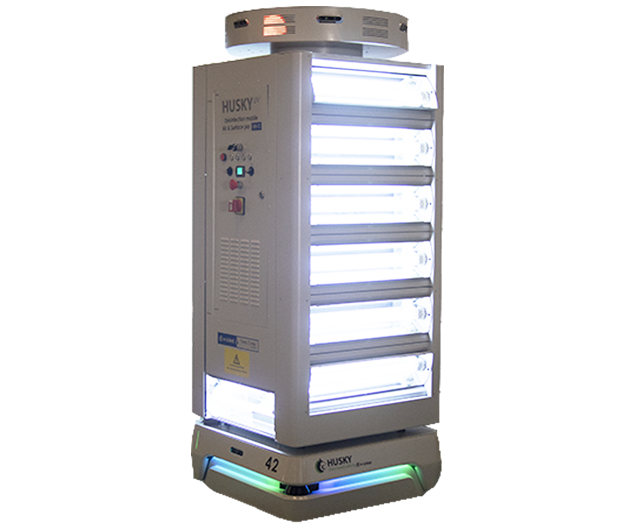
How does HUSKY UV work?
HUSKY-UV eliminates viruses and bacteria using UVC radiation. Tame-Care has selected UVC lamps technology for its energy efficiency and its ability to emit radiation within DNA and RNA maximum absorption wavelengths (254 nm peak), preventing microorganims replication, and providing an efficient biocidal effect.
An air filtration system is associated to UVC function for optimal air purification during disinfection cycles.
For mobility, the UVC turret is mounted on a cobot that can be remotely controlled and pre-programmed. Fully autonomous during its disinfection cycle, the HUSKY UV irradiates surfaces, walls and floors, eliminating up to 99.99% of viruses and bacteria.
Why should I use HUSKY UV?
HUSKY UV was designed to disinfect floor, surfaces and walls up to 2.5 m high. HUSKY UV is specifically qualified to disinfect surfaces with a high level of performance, masterizing the radiation emission to clean the surfaces.
Viruses or bacteria’s robustness to UVC is defined by the radiation dose required to reach 99.99% of inactivation. For example, this dose is 27 mW/cm² for SARS-CoV-2 strain. To ensure radiation dose threshold is met, HUSKY UV’s travelling speed can be adjusted. Other parameters such as the reflector angle and the distance from the targeted surface can be set upon user’s need.
Is HUSKY UV safe?
Since UVC radiation is harmful to health, HUSKY UV is equipped with safety elements, such as alarms and an intelligent camera system capable of detecting humans up to 7 m.
On top of this safety barrier, HUSKY UV also prevents staff from unhealthy environments. Indeed, chemical-free, UVC technology limits the exposure of cleaning staff to residual chemicals toxicity.
HUSKY UV offers a powerful, automated, adjustable and safe disinfection solution.
What is different with HUSKY UV?
HUSKY UV’s core innovation deals with radiation homogeneity and control.
Horizontal UVC tubes light much more homogeneously floor and highest surfaces than vertical tubes while maintaining the same performances on the wall.
Also, HUSKY UV considers the radiation dose around the robot and computes in real time the radiation emitted on the targeted wall to ensure they overreach the virus or bacteria defined threshold.
To meet the targeted radiation dose, HUSKY UV adapts its speed and travelling path (the received radiation is dependent on the exposure time and irradiance). One can also adjust the reflector angle to modify the emission intensity matrix from the HUSKY UV.
How efficient is HUSKY UV?
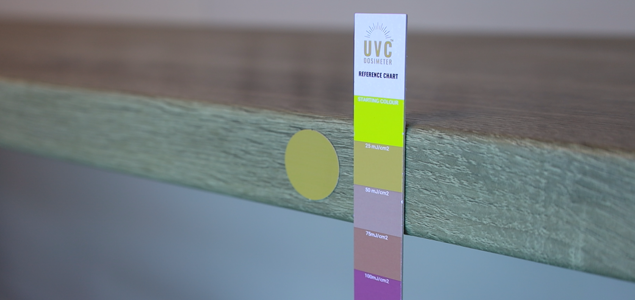
The efficiency depends on the UVC radiation dose provided on the surface (in mJ/cm²). It is proportional to the exposure time (in sec) and the irradiance (in mW/cm²).
The radiation dose required to inactivate viruses and bacteria vary from strain to strain. For example, to eliminate 99.99% of the SARS-CoV-2 virus, a dose of 27 mJ/cm² was determined to be required in literature.
In order to characterize the device, Tame-Care has established wall and floor irradiance mapping at various distances from the wall with HUSKY UV stationary. For this purpose, dosimetry dots that change color according to the received UVC dose were used. These dots go from a yellow color (no exposure) to a dark violet color (received dose of 100 mJ/cm²). Intermediate doses can be determined using a color scale (see Figure 1).
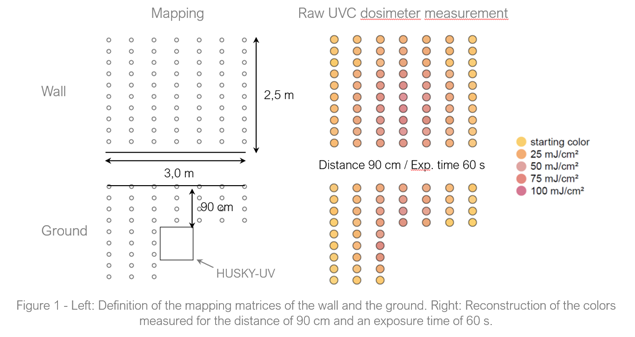
Each color was measured using a colorimeter to determine the UVC dose received by each dot (see Figure 2). These measurements were performed for three distances (50 cm, 90 cm and 130 cm) and three exposure times (30 sec, 60 sec, 120 sec). Assigning the color measurements to the reference table shows that the target dose of 25 mJ/cm² is reached over a large part of the wall and floor for a distance of 90 cm.
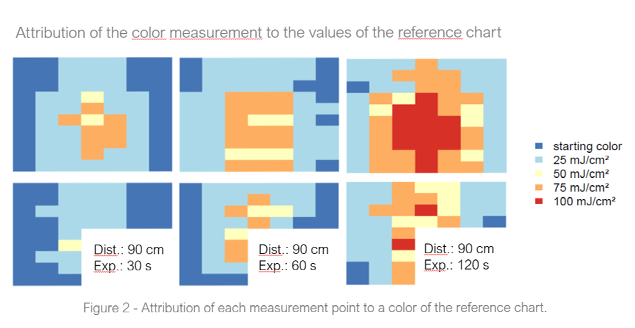
For each distance (50 cm, 90 cm, 130 cm) an average irradiance was determined (in mW/cm²) and is presented in figure 3. The dose (in mJ/cm²) can be calculated by multiplying the irradiance by the exposure time (in seconds).
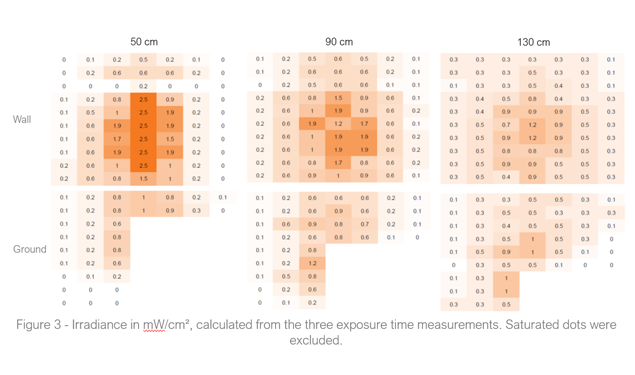
Which parameters for an efficient disinfection?
The parameters such as speed, distance between robot and wall and reflector orientation can be adapted to the user’s needs. If the requirement is a dose of 27 mJ/cm² up to a height of 2.50 m, the best setting would be a distance of 90 cm, which is a compromise of irradiance power and an even illumination. In this case, an inclination of +20°, +30°, +20°, -20°, -20°, -30° is recommended (outcome of optical simulations).
To reach a specific dose overall the wall, the limiting factor for the movement speed is the comparatively low dose near the ceiling. For example, let us calculate the movement speed at a height of 2.50 m to ensure a dose of 27 mJ/cm² (meaning 99.99% of SARS-CoV-2 deactivated):
The average irradiance over the length of 3 m is 0.314 mW/cm². The time required is the energy divided by the power: 27 mJ / 0.314 mW = 86 sec. Thus, speed is the lateral distance divided by the time: 300 cm / 86 sec = 3.5 cm/sec.
If the requirement is to direct the UVC light to specific heights at arm, hand or pelvis level, distance, movement speed and reflector inclination can be adjusted.
How long does it take to disinfect a typical room?
To answer this question, let us first have a look at the speed calculated in the section above, i.e., 3.5 cm/sec. With this value, it would take 28 sec to run along 1 m. The time can be shortened depending on the desired irradiation profile. The user should also note that HUSKY UV disinfects on its way there and back, e.g., when it runs along a floor.
As an example, complete disinfection of the walls and floor of a 4 m x 3 m large room would be achieved in 5 minutes.
Full publication with complete set of characterization data available upon request
Contact Tame-Care
by e-mailBecome a Tame-Care distributor!
Are you interested in our products and would you like to distribute them?
Become a distributor!

